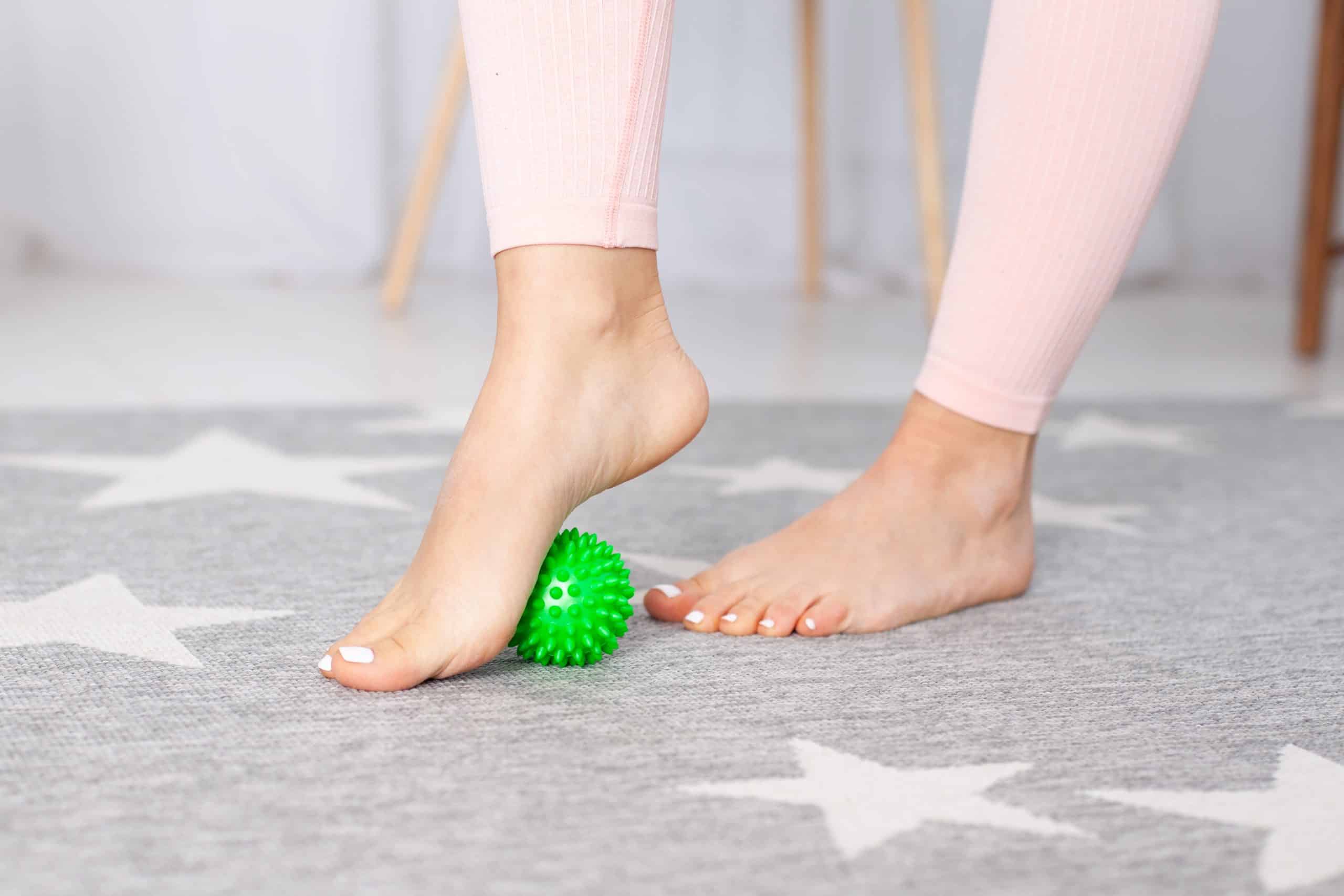When we think of muscles, we often think of pecs, quads, and of course—glutes. These are what define us aesthetically, helping to create the overall physique that we desire. However, there are other muscles in the body that don’t get nearly as much attention as they deserve—including the intrinsic muscles of the feet. Think about it. You use your feet every single day, yet we rarely even think about exercising them. This can lead to several problems, including weak feet, which can in turn lead to issues with balance, posture, and even pain in the knees, hips, and lower back. With that in mind, which muscles power your feet and how can you ensure that they stay strong? Read on to find out.
Get your personalized
meal plan!
What Are The Intrinsic Foot Muscles?
The muscles of the foot can be split into two groups, the extrinsic and intrinsic muscles (10).
Extrinsic muscles originate from outside of the foot and act on the ankle and toes to produce movement. When you move your foot up (dorsiflexion) or down (plantarflexion), it’s the extrinsic muscles that are doing the work.
The intrinsic muscles, on the other hand, are entirely contained within the foot itself. These muscles don’t produce movement at the ankle—instead, they act on the toes to produce movement (or lack thereof) (3).
When you curl your toes under (flexion) or point them away from your body (extension), it’s the intrinsic muscles that are doing the work (15).
Another essential function of intrinsic muscles (and the main reason we’re discussing them here) is that they help to stabilize the foot during movement and support the arch to maintain foot structure (15).
This is especially important when you’re standing on one leg or walking on uneven terrain. That is also why intrinsic muscle exercises are so important for injury prevention.
What Is The Importance Of Intrinsic Foot Strength?
From stabilizing the foot to supporting the arch, the intrinsic muscles play a very important role in overall foot health. However, these muscles are often overlooked—leading to weak feet that can lead to all sorts of problems.
Below are a few of the negative consequences of weak intrinsic foot muscles:
1. Plantar Fasciitis
Plantar fasciitis is a condition that results in pain in the heel and bottom of the foot. It’s often caused by overuse or repetitive motions (such as running) and can be pretty debilitating. The pain is worse in the morning or following exercise (12).
One of the best ways to prevent plantar fasciitis (or relieve it if you already have it) is to strengthen the intrinsic muscles of the feet. This will help to take the strain off of the plantar fascia (the connective tissue that runs along the bottom of the foot) and improve overall foot health.
Read More: Benefits Of Walking Barefoot On Grass: It Is Not Just A Fad!
2. Claw Toes
Claw toes occur when the joints of the toes become bent and fixed in place, causing them to curl under (16). This can be quite painful and make it difficult to walk or stand for long periods.
Claw toes are often caused by shoes that don’t fit properly or by diseases such as diabetes (13).
This deformity can be corrected through surgery, but strengthening the intrinsic muscles of the feet is a much less invasive option that can help prevent claw toes from occurring in the first place.
3. Hammer Toes
Hammer’s toes are similar to claw toes, but instead of curling under, the toe is bent at the middle joint, causing it to stick up (6). This can also be quite painful and make it difficult to walk or stand for long periods.
As with claw toes, hammer toes are often caused by shoes that don’t fit properly or by diseases such as diabetes (16).
Surgery is an option for correcting this deformity, but again, strengthening the intrinsic muscles of the feet is a much less invasive option that can help to prevent hammer toes from occurring in the first place.
4. Bunions/Hallux Vagus
A bunion is a deformity of the big toe joint that causes the toe to point outwards away from the foot. This can be quite painful, especially when wearing shoes (4).
Hallux valgus (a more severe form of bunion) can also cause the big toe to bend towards the second toe, which can be very uncomfortable (5).
Bunions and hallux valgus have several causes, including genetics, tight shoes, and arthritis. Treatment options for bunions and hallux valgus include changing to wider shoes, using orthotics or bunion pads, and surgery.
Foot intrinsic exercises will not help to improve bunions or hallux valgus, but they can help to improve the range of motion of the big toe and relieve pain.
5. Metatarsalgia
Metatarsalgia is a condition that causes pain in the ball of the foot (8). This is often due to high-impact activities such as running but can also be caused by shoes that don’t fit properly or by conditions such as bunions or hammertoes.
Metatarsalgia can make it very difficult to walk or stand for long periods. Treatment options include rest, ice, changing to wider shoes, and orthotics.
Exercises that strengthen the intrinsic muscles of the foot can also help to take the strain off of the metatarsals and relieve pain.
6. Achilles Tendonitis
Achilles tendonitis is a condition that causes pain in the Achilles tendon, which is the large tendon that runs down the back of the leg and connects the calf muscle to the heel bone (1) (2).
Achilles tendonitis is often caused by overuse or repetitive motions (such as running) and can be debilitating. The pain is worse when walking uphill or following exercise. Treatment options include rest, ice, and stretching.
Exercises that strengthen the intrinsic muscles of the foot can also help to take the strain off of the Achilles tendon and relieve pain.
7. Neuroma
A neuroma is a growth of nerve tissue that can occur in any part of the body. In the feet, neuromas often occur between the third and fourth toes (known as Morton’s neuroma) or between the second and third toes (9) (11).
Neuromas can cause tingling, numbness, or pain in the affected area. Treatment options include orthotics, injections, and surgery. Exercises that strengthen the intrinsic muscles of the foot can also help to take the strain off of the nerve and relieve pain.
If you tend to let yourself off the hook, raise the white flag when things get tougher than you expected, send yourself on an unconscious binge-eating trip – BetterMe app is here to help you leave all of these sabotaging habits in the past!
How Do You Strengthen Intrinsic Foot Muscles?
There are several exercises that you can do to strengthen the intrinsic muscles of your feet. These exercises can be done at home with no special equipment required.
Toe Taps
This exercise is great for strengthening the muscles that flex the toes.
To do this exercise:
- Sit in a chair with your feet flat on the floor.
- Lift your foot off of the floor and tap your toes on the floor in front of you.
- Repeat this 10 times on each foot.
Toe Raises
This exercise is great for strengthening the muscles that extend the toes.
To do this exercise:
- Sit in a chair with your feet flat on the floor.
- Lift your foot off of the floor and raise your toes towards your shin.
- Repeat this 10 times on each foot.
Toe Curls
This exercise is great for strengthening the muscles that out-toe (turn outwards) the foot.
To do this exercise:
- Sit in a chair with your feet flat on the floor.
- Lift your foot off of the floor and curl your toes downwards towards the floor.
- Repeat this 10 times on each foot.
Toe Spreads
This exercise is great for strengthening the muscles that invert (turn inwards) the foot.
To do this exercise:
- Sit in a chair with your feet flat on the floor.
- Lift your foot off of the floor and spread your toes outwards away from each other.
- Repeat this 10 times on each foot.
Read More: Working Out Barefoot (How To Do It The RIGHT Way)
Heel Raises
This exercise is great for strengthening the muscles that plantarflex (point downwards) the foot.
To do this exercise:
- Sit in a chair with your feet flat on the floor.
- Lift your heels off of the floor and raise your toes towards your shin.
- Repeat this 10 times on each foot.
Ankle Circles
This exercise is great for strengthening the muscles that out-toe (turn outwards) the foot.
To do this exercise:
- Sit in a chair with your feet flat on the floor.
- Lift your foot off of the floor and rotate your ankle in a circle.
- Repeat this 10 times in each direction on each foot.
Ankle Pumps
This exercise is great for strengthening the muscles that dorsiflex (bend upwards) the foot.
To do this exercise:
- Sit in a chair with your feet flat on the floor.
- Lift your foot off of the floor and bend your ankle upwards towards your shin.
- Repeat this 10 times on each foot.
Short Foot Exercise
Shortening the arch of the foot engages the small muscles in the foot and helps to improve balance and proprioception.
To do this exercise:
- Sit in a chair with your feet flat on the floor.
- Focus on bringing the base of the big toe and your heel together by arching your foot. Don’t curl your toes under. Keep your ankle still as you do this.
- You should feel a stretch along the bottom of your foot.
- Hold this position for 10 seconds and repeat it 10 times on each foot.
First Toe Extension
This exercise is great for strengthening the muscles that extend the big toe.
To do this exercise:
- Sit in a chair with your feet flat on the floor.
- Lift your first toe off of the floor and extend it straight out.
- Hold this position for 10 seconds and repeat it 10 times on each foot.
BetterMe app is a foolproof way to go from zero to a weight loss hero in a safe and sustainable way! What are you waiting for? Start transforming your body now!
Other Ways To Strengthen Intrinsic Foot Muscles
In addition to exercises that specifically target the intrinsic foot muscles, other activities can help to strengthen these muscles. These activities include:
- Walking barefoot – This allows the muscles in the feet to work harder as they adjust to uneven surfaces and provide stability.
- Pilates and yoga – These activities often incorporate exercises that target the intrinsic foot muscles.
- Balance training – Exercises that challenge balance, such as standing on one leg or walking on a balance beam, can help to strengthen the muscles in the feet.
- Wearing supportive shoes – shoes with a low heel and good arch support can help to reduce strain on the foot muscles (14).
- Wearing the right size shoes – shoes that are too big or too small can contribute to foot muscle strain (7).
When To See A Doctor
Intrinsic foot muscle weakness can often be improved with exercises and other self-care measures. However, if these measures do not improve the condition, or if the foot muscles are significantly weakened, it is important to see a doctor.
A doctor can rule out other conditions that may be causing muscle weakness and develop a treatment plan to help improve the condition.
The Bottom Line
The intrinsic foot muscles are a group of small muscles that are located entirely within the foot. These muscles are responsible for moving the toes and helping to maintain balance. Intrinsic foot muscle weakness can often be improved with exercises that target these muscles.
However, if these exercises do not improve the condition, or if the foot muscles are significantly weakened, it is important to see a doctor. They can rule out other conditions that may be causing the muscle weakness and develop a treatment plan to help improve the condition.
DISCLAIMER:
This article is intended for general informational purposes only and does not serve to address individual circumstances. It is not a substitute for professional advice or help and should not be relied on for making any kind of decision-making. Any action taken as a direct or indirect result of the information in this article is entirely at your own risk and is your sole responsibility.
BetterMe, its content staff, and its medical advisors accept no responsibility for inaccuracies, errors, misstatements, inconsistencies, or omissions and specifically disclaim any liability, loss or risk, personal, professional or otherwise, which may be incurred as a consequence, directly or indirectly, of the use and/or application of any content.
You should always seek the advice of your physician or other qualified health provider with any questions you may have regarding a medical condition or your specific situation. Never disregard professional medical advice or delay seeking it because of BetterMe content. If you suspect or think you may have a medical emergency, call your doctor.
SOURCES:
- Achilles Tendinopathy: Current Concepts about the Basic Science and Clinical Treatments (2016, hindawi.com)
- Achilles Tendonitis (2022, ncbi.nlm.nih.gov)
- Anatomy, Bony Pelvis and Lower Limb, Foot Muscles (2022, ncbi.nlm.nih.gov)
- Bunions: Overview (2021, ncbi.nlm.nih.gov)
- Hallux Valgus (2022, ncbi.nlm.nih.gov)
- Hammertoe (2022, ncbi.nlm.nih.gov)
- Incorrectly fitted footwear, foot pain and foot disorders: a systematic search and narrative review of the literature (2018, biomedcentral.com)
- Metatarsalgia (2010, pubmed.ncbi.nlm.nih.gov)
- Morton’s Neuroma – an overview (n.d., sciencedirect.com)
- Muscles of the Foot – Dorsal – Plantar (n.d., teachmeanatomy.info)
- Neuroma (2022, ncbi.nlm.nih.gov)
- Plantar Fasciitis (2022, ncbi.nlm.nih.gov)
- Role of Intrinsic Muscle Atrophy in the Etiology of Claw Toe Deformity in Diabetic Neuropathy May Not Be as Straightforward as Widely Believed (2009, diabetesjournals.org)
- The effect of minimal shoes on arch structure and intrinsic foot muscle strength (2014, sciencedirect.com)
- The foot core system: a new paradigm for understanding intrinsic foot muscle function | British Journal of Sports Medicine (2015, bmj.com)
- The pathology and management of lesser toe deformities (2016, ncbi.nlm.nih.gov)













